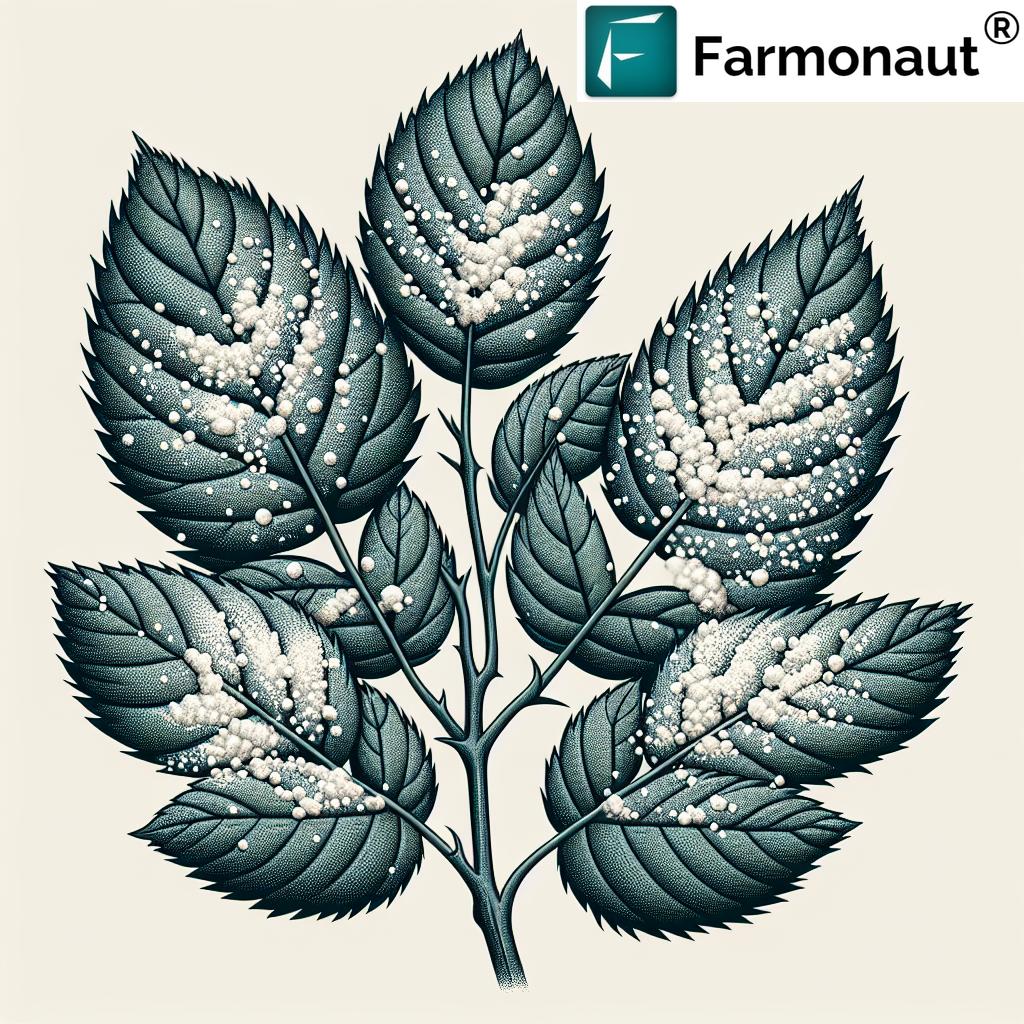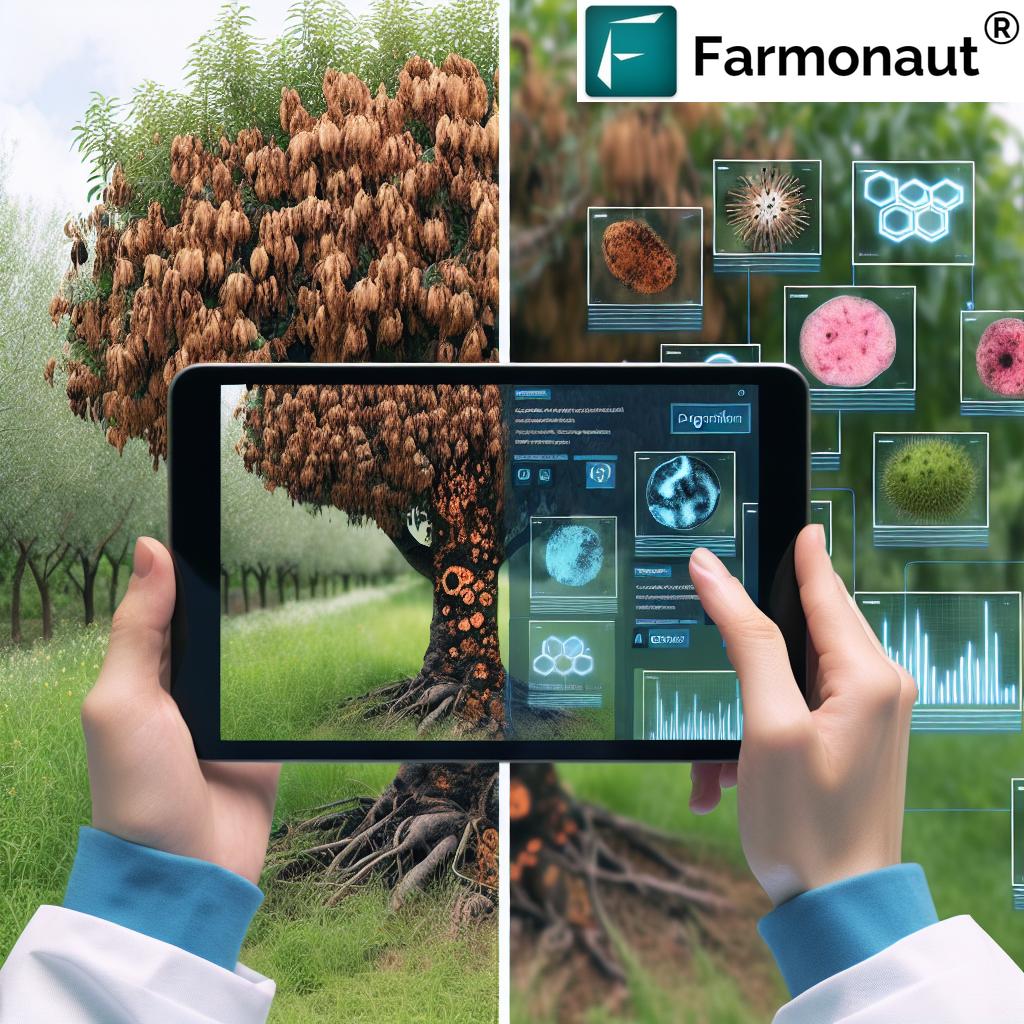Effective Organic Powdery Mildew Treatment: Integrated Pest Management for Rose Protection

As passionate rose enthusiasts and agricultural experts, we at Farmonaut understand the challenges that come with maintaining healthy, vibrant rose gardens. One of the most common and persistent issues faced by rose growers is powdery mildew, a fungal disease that can quickly spread and devastate your beloved plants. In this comprehensive guide, we’ll explore effective organic treatments and integrated pest management (IPM) strategies to combat powdery mildew, ensuring your roses remain healthy and beautiful throughout the growing season.
Understanding Powdery Mildew in Roses
Powdery mildew is a fungal disease that affects a wide range of plants, including roses. It’s caused by various species of fungi, primarily belonging to the Erysiphales order. This disease thrives in warm, humid conditions and can spread rapidly if left unchecked.
Symptoms of Powdery Mildew on Roses
- White or grayish-white powdery spots on leaves, stems, and buds
- Distorted or curled leaves
- Stunted growth
- Reduced flower production
- Premature leaf drop
Early detection is crucial for effective control of powdery mildew. At Farmonaut, we’ve developed advanced satellite-based monitoring systems that can detect early signs of plant stress, including powdery mildew infections, across large rose plantations.
Traditional vs. Farmonaut Satellite System for Powdery Mildew Detection
| Aspect | Traditional Detection | Farmonaut Satellite System |
|---|---|---|
| Detection Speed | Slow – Requires manual inspection | Fast – Real-time satellite imagery analysis |
| Accuracy | Moderate – Dependent on human expertise | High – AI-powered image analysis |
| Coverage Area | Limited – Time-consuming for large plantations | Extensive – Can cover vast areas quickly |
| Cost-effectiveness | Low – Labor-intensive | High – Automated and scalable |
Our satellite-based system enables timely and targeted IPM interventions, significantly improving the efficiency of powdery mildew management in large-scale rose cultivation.
Organic Treatment Options for Powdery Mildew
When it comes to treating powdery mildew on roses, organic methods are often preferred by gardeners and commercial growers alike. These treatments are not only effective but also environmentally friendly and safe for beneficial insects.
1. Milk Spray
A simple yet effective organic treatment for powdery mildew is a milk spray. Mix one part milk with nine parts water and spray it on affected plants. The proteins in milk create an antiseptic effect when exposed to sunlight, helping to control the fungus.
2. Neem Oil
Neem oil is a versatile organic pesticide that can effectively control powdery mildew. Mix 1 tablespoon of neem oil with 1 quart of water and a few drops of mild liquid soap. Spray this solution on your roses, covering all parts of the plant, including the undersides of leaves.
3. Baking Soda Solution
A baking soda spray can help prevent and treat powdery mildew. Mix 1 tablespoon of baking soda with 1 gallon of water and a few drops of liquid soap. This solution changes the pH on the leaf surface, making it inhospitable for the fungus.
4. Sulfur-Based Fungicides
Sulfur is an effective organic fungicide against powdery mildew. It’s available in powder or liquid form and should be applied according to the manufacturer’s instructions. However, avoid using sulfur when temperatures exceed 85°F (29°C) as it can damage plants.
5. Potassium Bicarbonate
Similar to baking soda, potassium bicarbonate can effectively control powdery mildew. Mix 1 tablespoon of potassium bicarbonate with 1 gallon of water and a few drops of liquid soap. This solution not only prevents but can also eradicate existing powdery mildew infections.
Integrated Pest Management (IPM) for Powdery Mildew Control
At Farmonaut, we strongly advocate for an Integrated Pest Management (IPM) approach to control powdery mildew in roses. IPM combines various strategies to manage pests and diseases effectively while minimizing environmental impact.
Key Components of IPM for Powdery Mildew Control:
- Prevention: Implement cultural practices that create unfavorable conditions for powdery mildew development.
- Monitoring: Regularly inspect plants and use advanced technologies like our satellite-based system for early detection.
- Cultural Controls: Employ techniques that promote plant health and reduce disease susceptibility.
- Biological Controls: Utilize beneficial microorganisms that can help control powdery mildew.
- Chemical Controls: Use organic fungicides as a last resort, applying them judiciously and responsibly.
Prevention Strategies
- Choose resistant rose varieties when planting new roses.
- Ensure proper spacing between plants to improve air circulation.
- Avoid overhead watering, which can create humid conditions favorable for powdery mildew.
- Prune roses regularly to improve air circulation within the plant.
Cultural Controls
- Remove and destroy infected plant parts to prevent the spread of the disease.
- Maintain proper plant nutrition to boost natural resistance.
- Use mulch to prevent water splashing, which can spread fungal spores.
- Implement proper sanitation practices in your garden or plantation.
Biological Controls
Several beneficial microorganisms can help in controlling powdery mildew:
- Bacillus subtilis: This beneficial bacterium can colonize plant surfaces, preventing powdery mildew spores from germinating.
- Trichoderma harzianum: A fungus that parasitizes powdery mildew and other plant pathogens.
- Ampelomyces quisqualis: A hyperparasite that specifically attacks powdery mildew fungi.
These biological control agents are available as commercial products and can be integrated into your IPM strategy.
Advanced Technology in Powdery Mildew Management
At Farmonaut, we leverage cutting-edge technology to enhance powdery mildew management in large-scale rose cultivation. Our satellite-based crop health monitoring system provides valuable insights that can significantly improve the efficiency of IPM strategies.
Satellite-Based Early Detection
Our advanced satellite imagery analysis can detect subtle changes in plant health that may indicate the early stages of powdery mildew infection. This allows for prompt intervention before the disease can spread widely.
AI-Powered Advisory System
Our Jeevn AI advisory system analyzes satellite data, weather patterns, and historical information to provide personalized recommendations for powdery mildew management. This includes optimal timing for preventive spraying and alerts for high-risk periods.
Precision Application of Treatments
By identifying specific areas of infection, our system enables targeted application of treatments, reducing overall pesticide use and improving cost-effectiveness.
To learn more about how Farmonaut’s technology can revolutionize your rose cultivation practices, visit our app or explore our API services.
Best Practices for Organic Powdery Mildew Treatment
When implementing organic treatments for powdery mildew, it’s essential to follow best practices to ensure maximum effectiveness and plant safety:
- Timing is crucial: Apply treatments early in the morning or late in the evening when temperatures are cooler.
- Thorough coverage: Ensure all parts of the plant, including the undersides of leaves, are covered with the treatment solution.
- Regular application: Most organic treatments need to be reapplied every 7-14 days or after rain for continued protection.
- Test before widespread use: Always test any new treatment on a small area first to ensure it doesn’t damage your roses.
- Rotate treatments: To prevent resistance, rotate between different organic control methods.
- Combine with cultural practices: Organic treatments are most effective when combined with good cultural practices like proper pruning and watering.
The Role of Plant Resistance in Powdery Mildew Management
Developing and utilizing rose varieties with natural resistance to powdery mildew is a crucial aspect of long-term disease management. At Farmonaut, we collaborate with plant breeders and researchers to identify and promote resistant varieties.
Benefits of Resistant Rose Varieties:
- Reduced need for fungicide applications
- Lower maintenance requirements
- Improved overall plant health and vigor
- More sustainable and environmentally friendly cultivation
While no rose variety is completely immune to powdery mildew, those with higher resistance levels can significantly reduce the disease’s impact and management costs.
Water Management and Powdery Mildew Control
Proper water management plays a crucial role in preventing and controlling powdery mildew in roses. While the fungus doesn’t require free water to infect plants, high humidity can create favorable conditions for its growth.
Effective Water Management Strategies:
- Drip irrigation: Use drip irrigation or soaker hoses to water plants at the base, avoiding wetting the foliage.
- Timing: Water early in the day to allow foliage to dry before evening.
- Mulching: Apply organic mulch around plants to reduce water splashing and maintain consistent soil moisture.
- Proper spacing: Ensure adequate spacing between plants to promote air circulation and reduce humidity.
Our satellite-based soil moisture monitoring can help optimize irrigation practices, reducing the risk of creating conditions favorable for powdery mildew development.
The Future of Powdery Mildew Management in Roses
As technology continues to advance, we at Farmonaut are at the forefront of developing innovative solutions for powdery mildew management in roses. Some exciting developments on the horizon include:
- Gene editing: CRISPR technology may allow for the development of roses with enhanced natural resistance to powdery mildew.
- Nanotechnology: Nanoparticle-based fungicides could provide more effective and longer-lasting protection against powdery mildew.
- AI-driven predictive models: Advanced algorithms could predict powdery mildew outbreaks with greater accuracy, allowing for preemptive action.
- Drone-based application systems: Precision application of treatments using drones could revolutionize large-scale rose cultivation.
Stay updated on these advancements and more by following Farmonaut’s latest developments through our Android and iOS apps.
Conclusion
Effective management of powdery mildew in roses requires a multifaceted approach that combines organic treatments, integrated pest management strategies, and advanced technology. By implementing the methods and best practices outlined in this guide, you can protect your roses from this persistent fungal disease while maintaining a healthy and sustainable garden or plantation.
At Farmonaut, we’re committed to providing innovative solutions that empower growers to manage plant health more effectively and sustainably. Our satellite-based monitoring systems, AI-powered advisory services, and continuous research efforts are designed to revolutionize rose cultivation and disease management.
For more information on how Farmonaut can help you protect your roses from powdery mildew and other threats, visit our website or explore our comprehensive API documentation.
FAQs
- Q: How often should I apply organic treatments for powdery mildew?
A: Most organic treatments should be applied every 7-14 days or after rain. However, always follow the specific instructions for each treatment method. - Q: Can powdery mildew spread to other plants in my garden?
A: Yes, powdery mildew can spread to other susceptible plants. It’s important to treat infected plants promptly and maintain good garden hygiene. - Q: Are there any rose varieties that are completely immune to powdery mildew?
A: While no rose variety is completely immune, many cultivars have been bred for high resistance to powdery mildew. Consult with local nurseries or rose societies for recommendations suited to your area. - Q: Can I use chemical fungicides along with organic treatments?
A: It’s generally best to stick with either organic or chemical treatments to avoid potential interactions. If you decide to use chemical fungicides, follow all safety precautions and application instructions carefully. - Q: How can Farmonaut’s technology help me manage powdery mildew in my large rose plantation?
A: Farmonaut’s satellite-based monitoring system can detect early signs of plant stress, including powdery mildew infections, across large areas. This allows for timely and targeted interventions, improving the efficiency of your disease management efforts.

Subscribe to Farmonaut Services













